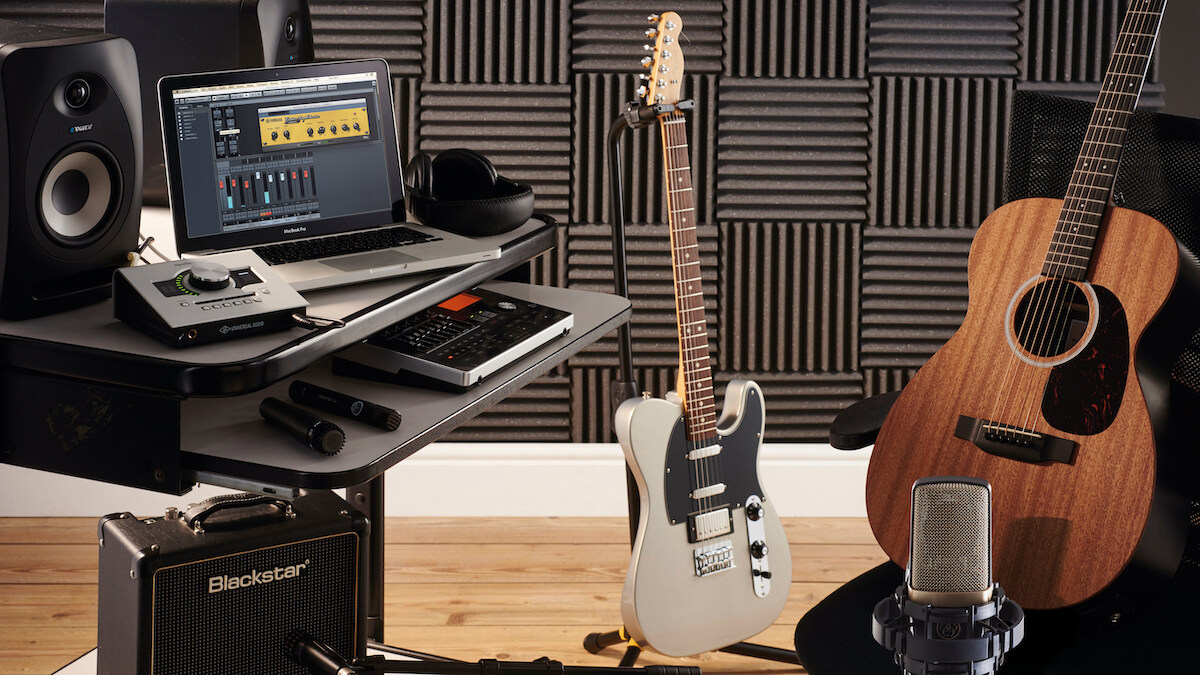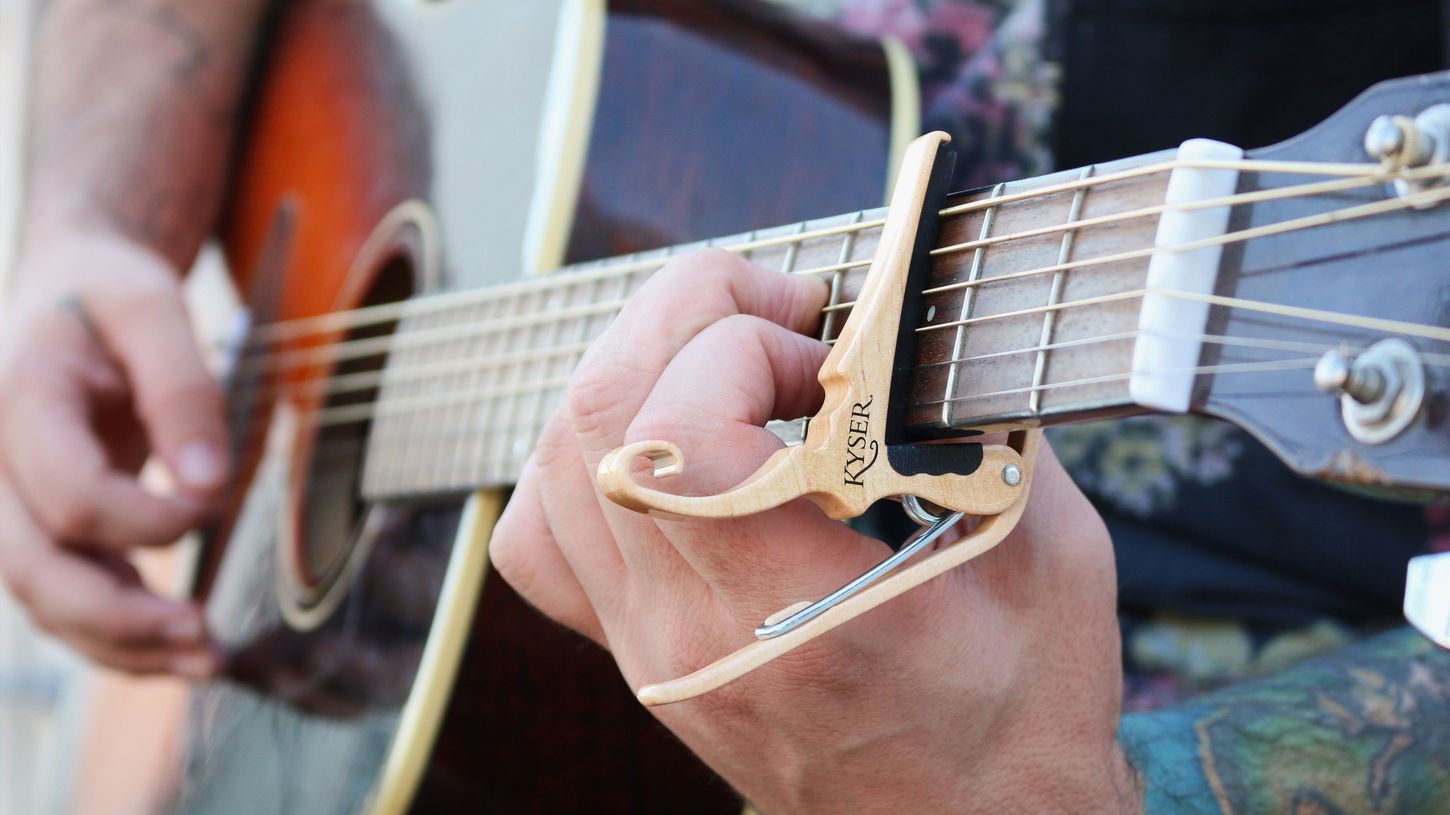Home>Instruments>Guitar>How To Use A Guitar Tuner


Guitar
How To Use A Guitar Tuner
Modified: February 15, 2024
Learn how to use a guitar tuner to keep your instrument in perfect pitch. Our step-by-step guide will help you tune your guitar quickly and accurately. Perfect for beginners and experienced players alike!
(Many of the links in this article redirect to a specific reviewed product. Your purchase of these products through affiliate links helps to generate commission for AudioLover.com, at no extra cost. Learn more)
Table of Contents
Introduction
Introduction
Playing the guitar is a rewarding experience, but ensuring that your instrument is in tune is essential for producing beautiful music. A guitar tuner is a valuable tool that helps musicians achieve the perfect pitch for each string. Whether you're a beginner or an experienced player, understanding how to use a guitar tuner is crucial for honing your skills and creating harmonious melodies.
Guitar tuners come in various forms, including clip-on tuners, pedal tuners, and smartphone app tuners. Each type offers unique features and benefits, catering to different preferences and playing environments. By familiarizing yourself with these options and learning how to use them effectively, you can elevate your playing abilities and enjoy a more satisfying musical journey.
In this comprehensive guide, we will explore the different types of guitar tuners and provide step-by-step instructions on how to use them. Additionally, we'll share valuable tips to enhance your tuning experience and ensure that your guitar always produces the perfect sound. Whether you're preparing for a live performance, a recording session, or a casual jam session with friends, mastering the art of using a guitar tuner will undoubtedly elevate your musical prowess. So, let's dive in and discover the secrets of achieving flawless guitar tuning.
Types of Guitar Tuners
Types of Guitar Tuners
When it comes to tuning your guitar, there are several types of guitar tuners available, each offering unique features and benefits. Understanding the differences between these tuners can help you choose the one that best suits your playing style and preferences. Here are the most common types of guitar tuners:
- Clip-On Tuners: Clip-on tuners are compact devices that attach directly to the headstock of the guitar. They detect vibrations from the instrument, allowing for accurate tuning even in noisy environments. Clip-on tuners are convenient, portable, and ideal for both acoustic and electric guitars.
- Pedal Tuners: Pedal tuners are designed to be used with electric guitars and are housed in a stompbox pedal format. They are often integrated into pedalboards and offer easy visibility on stage. Pedal tuners are suitable for live performances and provide quick and accurate tuning adjustments.
- Smartphone App Tuners: With the advancement of technology, smartphone app tuners have become increasingly popular. These tuners utilize the microphone of a smartphone to analyze the pitch of each string. They are convenient for practicing at home or on the go, offering a cost-effective tuning solution.
Each type of guitar tuner has its own advantages, and the choice ultimately depends on your specific needs and playing circumstances. Now that we’ve explored the different types of guitar tuners, let’s delve into the specifics of how to use each type effectively.
How to Use a Clip-On Tuner
How to Use a Clip-On Tuner
Clip-on tuners are popular among guitarists due to their portability and ease of use. Here’s a step-by-step guide on how to use a clip-on tuner effectively:
- Attach the Tuner: Position the clip-on tuner onto the headstock of your guitar. Ensure that it is securely fastened to accurately detect the instrument’s vibrations.
- Power On the Tuner: Activate the tuner by pressing the power button. Some clip-on tuners feature an automatic on/off function, while others may require manual operation.
- Tune Each String: Pluck each string individually and observe the tuner’s display. The tuner will indicate whether the pitch is too high, too low, or in tune. Adjust the tuning pegs accordingly to match the desired pitch for each string.
- Strum and Verify: After tuning each string, strum the guitar to ensure that all strings harmonize with each other. Make any necessary adjustments to achieve overall tuning balance.
- Power Off the Tuner: Once you’ve completed the tuning process, power off the clip-on tuner to conserve its battery life for future use.
Clip-on tuners are convenient for both acoustic and electric guitars, providing accurate tuning results even in noisy environments. Their compact size and easy attachment make them a practical choice for musicians on the go. By following these simple steps, you can effectively use a clip-on tuner to keep your guitar in perfect tune for practice sessions, performances, and recording sessions.
How to Use a Pedal Tuner
How to Use a Pedal Tuner
Pedal tuners are a popular choice for electric guitarists, offering convenience and accuracy during live performances and studio recording sessions. Here’s a comprehensive guide on how to use a pedal tuner effectively:
- Connect the Tuner: Insert the input jack of your guitar into the input of the pedal tuner, and then connect the output of the tuner to your amplifier or other effects pedals if you’re using a pedalboard setup.
- Power On the Tuner: Activate the pedal tuner by stepping on the designated footswitch. Some pedal tuners feature a bright LED display that is easily visible on stage, providing clear visual feedback for tuning adjustments.
- Tune Each String: Play each string individually and observe the tuner’s display. The display will indicate whether the pitch is too high, too low, or in tune. Use the tuning pegs to adjust the pitch of each string until it aligns with the desired note.
- Verify the Tuning: Strum the guitar and listen carefully to ensure that all strings are accurately tuned. Make any necessary adjustments to achieve perfect harmony across the instrument.
- Power Off the Tuner: Once you’ve completed the tuning process, deactivate the pedal tuner to conserve its battery or power supply for future use.
Pedal tuners are designed for quick and accurate tuning adjustments, making them an essential tool for professional and amateur electric guitar players. Their robust construction and visibility on stage provide added confidence during performances. By following these steps, you can effectively utilize a pedal tuner to maintain precise tuning for your electric guitar, whether you’re rocking out on stage or laying down tracks in the studio.
How to Use a Smartphone App Tuner
How to Use a Smartphone App Tuner
Smartphone app tuners have revolutionized the way guitarists tune their instruments, offering a convenient and cost-effective solution for practicing and performing. Here’s a detailed guide on how to effectively use a smartphone app tuner:
- Download a Tuning App: Visit your smartphone’s app store and download a reputable guitar tuning app. There are numerous free and paid options available, each offering various features and tuning capabilities.
- Open the App and Select Tuning Mode: Launch the tuning app and choose the tuning mode that corresponds to your guitar’s tuning requirements. Standard tuning (EADGBE) is the most common, but the app may offer alternative tunings as well.
- Allow Microphone Access: Grant the app permission to access your smartphone’s microphone. This allows the app to listen to the sound of your guitar and analyze the pitch of each string.
- Pluck and Tune Each String: Pluck each string individually and observe the app’s visual display or indicator. The app will provide real-time feedback on whether the string is flat, sharp, or in tune. Adjust the tuning pegs to match the desired pitch for each string.
- Verify Overall Tuning: Strum the guitar to ensure that all strings are in harmony with each other. Make any necessary adjustments to achieve balanced and accurate tuning across the instrument.
Smartphone app tuners are convenient for practicing at home, in the studio, or on the go, offering a portable tuning solution without the need for additional hardware. They are ideal for acoustic and electric guitars, providing versatility and ease of use. By following these steps, you can effectively utilize a smartphone app tuner to keep your guitar perfectly tuned for rehearsals, performances, and creative musical endeavors.
Tips for Using a Guitar Tuner
Tips for Using a Guitar Tuner
Mastering the art of using a guitar tuner involves more than just following the basic instructions. Here are some valuable tips to enhance your tuning experience and ensure that your guitar always produces the perfect sound:
- Understand the Tuning Mode: Familiarize yourself with the various tuning modes offered by your tuner, including standard tuning, alternate tunings, and chromatic mode. Each mode serves specific tuning needs and can expand your creative possibilities.
- Strum Gently: When tuning with a clip-on or pedal tuner, strum the strings gently to avoid excessive vibration that may interfere with accurate detection. This allows the tuner to register the natural pitch of each string more effectively.
- Double-Check Open Strings: After tuning each string, revisit the open strings to verify their pitch. This ensures that the tuning stability is maintained across all strings, especially when transitioning between different tunings.
- Use Reference Tones: Some tuners provide reference tones for each string, aiding in ear training and pitch recognition. Take advantage of these tones to develop your musical ear and improve your tuning accuracy.
- Regular Maintenance: Keep your tuner clean and free from dust or debris that may affect its functionality. Additionally, replace the batteries or recharge the power source as needed to maintain consistent performance.
- Explore Calibration Options: Many tuners offer calibration settings to adjust the reference pitch. Experiment with calibration to match the tuning standard of other instruments or accommodate specific musical contexts.
- Practice Tuning by Ear: While tuners are valuable tools, practicing tuning by ear can sharpen your musical skills and deepen your connection to the instrument. Use the tuner as a reference and gradually rely more on your ear for tuning.
By incorporating these tips into your tuning routine, you can elevate your tuning proficiency and develop a keen sense of pitch and harmony. Whether you’re a beginner or an experienced guitarist, these insights will enhance your tuning process and contribute to a more enjoyable and rewarding musical journey.
Conclusion
Conclusion
Mastering the art of using a guitar tuner is a fundamental skill that empowers guitarists to achieve optimal sound quality and musical expression. Whether you opt for a clip-on tuner, a pedal tuner, or a smartphone app tuner, the key lies in understanding the nuances of each type and employing effective tuning techniques.
By familiarizing yourself with the different types of guitar tuners and learning how to use them proficiently, you can elevate your playing experience and ensure that your instrument is always in perfect tune. Whether you’re practicing at home, performing on stage, or recording in the studio, a well-tuned guitar is essential for delivering captivating performances and expressing your musical creativity.
Furthermore, incorporating valuable tips into your tuning routine can enhance your overall musical journey, nurturing a deeper connection to your instrument and honing your ear for pitch and harmony. From exploring various tuning modes to practicing tuning by ear, these insights offer an enriching approach to achieving precise and consistent tuning results.
As you continue to refine your tuning skills and expand your musical repertoire, remember that a well-tuned guitar is the cornerstone of captivating performances and fulfilling musical experiences. Embrace the art of using a guitar tuner as a gateway to unlocking the full potential of your instrument and expressing your unique musical voice with confidence and precision.
So, whether you’re strumming gentle melodies or unleashing powerful riffs, let the harmonious resonance of a perfectly tuned guitar inspire and elevate your musical endeavors, enriching the lives of both the player and the audience.











